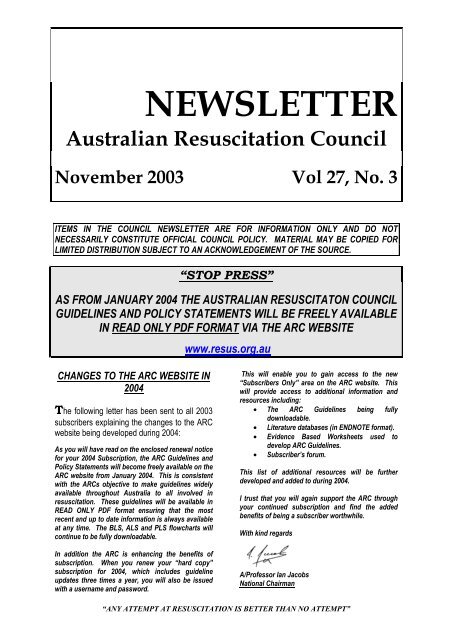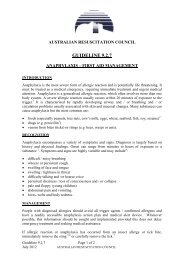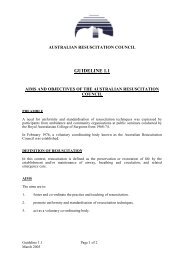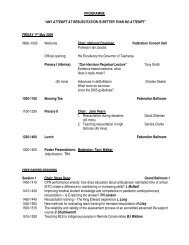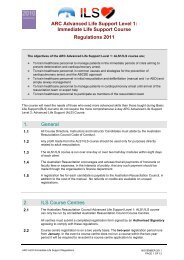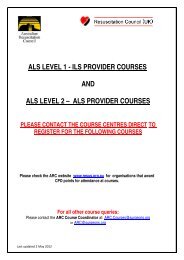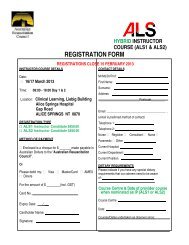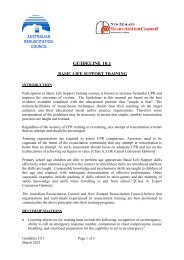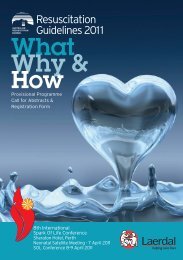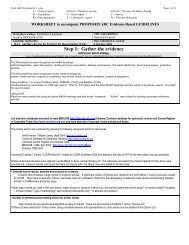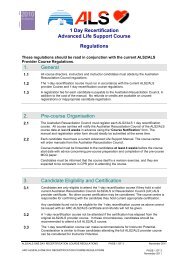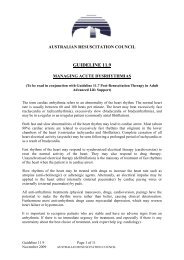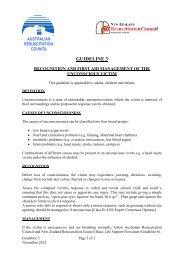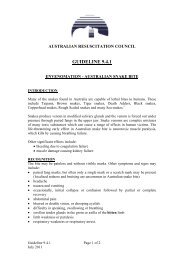Newsletter November 2003 - Australian Resuscitation Council
Newsletter November 2003 - Australian Resuscitation Council
Newsletter November 2003 - Australian Resuscitation Council
You also want an ePaper? Increase the reach of your titles
YUMPU automatically turns print PDFs into web optimized ePapers that Google loves.
NEWSLETTER<br />
<strong>Australian</strong> <strong>Resuscitation</strong> <strong>Council</strong><br />
<strong>November</strong> <strong>2003</strong> Vol 27, No. 3<br />
ITEMS IN THE COUNCIL NEWSLETTER ARE FOR INFORMATION ONLY AND DO NOT<br />
NECESSARILY CONSTITUTE OFFICIAL COUNCIL POLICY. MATERIAL MAY BE COPIED FOR<br />
LIMITED DISTRIBUTION SUBJECT TO AN ACKNOWLEDGEMENT OF THE SOURCE.<br />
“STOP PRESS”<br />
AS FROM JANUARY 2004 THE AUSTRALIAN RESUSCITATON COUNCIL<br />
GUIDELINES AND POLICY STATEMENTS WILL BE FREELY AVAILABLE<br />
IN READ ONLY PDF FORMAT VIA THE ARC WEBSITE<br />
www.resus.org.au<br />
CHANGES TO THE ARC WEBSITE IN<br />
2004<br />
The following letter has been sent to all <strong>2003</strong><br />
subscribers explaining the changes to the ARC<br />
website being developed during 2004:<br />
As you will have read on the enclosed renewal notice<br />
for your 2004 Subscription, the ARC Guidelines and<br />
Policy Statements will become freely available on the<br />
ARC website from January 2004. This is consistent<br />
with the ARCs objective to make guidelines widely<br />
available throughout Australia to all involved in<br />
resuscitation. These guidelines will be available in<br />
READ ONLY PDF format ensuring that the most<br />
recent and up to date information is always available<br />
at any time. The BLS, ALS and PLS flowcharts will<br />
continue to be fully downloadable.<br />
In addition the ARC is enhancing the benefits of<br />
subscription. When you renew your “hard copy”<br />
subscription for 2004, which includes guideline<br />
updates three times a year, you will also be issued<br />
with a username and password.<br />
This will enable you to gain access to the new<br />
“Subscribers Only” area on the ARC website. This<br />
will provide access to additional information and<br />
resources including:<br />
• The ARC Guidelines being fully<br />
downloadable.<br />
• Literature databases (in ENDNOTE format).<br />
• Evidence Based Worksheets used to<br />
develop ARC Guidelines.<br />
• Subscriber’s forum.<br />
This list of additional resources will be further<br />
developed and added to during 2004.<br />
I trust that you will again support the ARC through<br />
your continued subscription and find the added<br />
benefits of being a subscriber worthwhile.<br />
With kind regards<br />
A/Professor Ian Jacobs<br />
National Chairman<br />
“ANY ATTEMPT AT RESUSCITATION IS BETTER THAN NO ATTEMPT”
ARC <strong>Newsletter</strong> Vol. 27 No. 3<br />
<strong>November</strong> <strong>2003</strong><br />
SPARK OF LIFE CONFERENCE 15-16<br />
APRIL 2005 - ADELAIDE<br />
<strong>Council</strong> has decided that the registration fee<br />
for the 2005 SOL conference will be:<br />
$350 plus GST ($385)<br />
The call for abstract, preliminary program and<br />
registration booklet will be distributed after the<br />
July 2004 <strong>Council</strong> meeting. Keep an eye on<br />
the ARC website for all the latest news about<br />
the forthcoming conference.<br />
ILCOR<br />
The most recent ILCOR meeting was held in<br />
Brazil in September of this year. Three ARC<br />
representatives attended and reported that it<br />
was a good meeting with a lot of useful work<br />
being completed. They all agreed it was a long<br />
way to travel and perhaps <strong>Council</strong> should<br />
discourage the choice of remote areas for<br />
future ILCOR meetings. The next meeting will<br />
be held in Dallas in March 2004.<br />
“COUGH CPR”<br />
The issue of self administered cough CPR has<br />
once again been raised as an alternative way<br />
of treating cardiac arrest. The ARC, the<br />
National Heart Foundation and the American<br />
Heart Association (AHA) do not advocate this<br />
technique as it does not apply to<br />
those suffering a cardiac arrest and is<br />
impractical. This is because the first sign of<br />
cardiac arrest is unconsciousness which makes<br />
it impossible to self administer cough CPR.<br />
In cases where patients have some symptoms,<br />
i.e. chest pain, they should rest and call 000 for<br />
an ambulance. The ARC and National Heart<br />
Foundation will soon release a joint statement<br />
on this issue.<br />
DEATH OF PETER SAFAR<br />
On August 4 th , <strong>2003</strong> Peter Safar, MD,<br />
distinguished Professor of <strong>Resuscitation</strong><br />
Medicine at the University of Pittsburgh School<br />
of Medicine, died at the age of 79 years.<br />
Known as the father of modern day<br />
cardiopulmonary resuscitation, Dr Safar’s<br />
research efforts and accomplishments in<br />
emergency medicine, critical care medicine and<br />
resuscitation research have saved many lives<br />
and gained international recognition.<br />
In the 1950s at Baltimore City Hospital, Dr<br />
Safar documented, with experiments on human<br />
volunteers, cardiopulmonary resuscitation<br />
(CPR) step A (airway control by backward tilt of<br />
the head, jaw thrust and open mouth) and step<br />
B (the superiority of mouth-to-mouth over<br />
manual artificial ventilation). He combined<br />
steps A and B with step C (closed-chest<br />
cardiac massage, rediscovered and<br />
documented by others) into basic life support<br />
(BLS). Dr Safar is survived by his wife and two<br />
sons.<br />
“Newsflash!”<br />
The ARC is currently reviewing policy<br />
statement 8.9.6 Envenomation - Jellyfish<br />
Stings. This policy statement will be put into<br />
the new guidelines format and will reflect the<br />
latest evidence available. It has, however<br />
come to our attention that there is an error in<br />
the current policy statement (page 6 of 7)<br />
where it suggests that aspirin should be given<br />
to children. This statement is incorrect and<br />
should read that "age related analgesia<br />
should be given to children to relieve pain".<br />
Aspirin is not recommended to be given to<br />
children.<br />
ARC SOUTH AUSTRALIAN BRANCH<br />
NEWS<br />
CD Rom of presentations from the<br />
April <strong>2003</strong> “Steps to Survival” Conference<br />
Cost $10 + $2.50 post & packing<br />
Please order your copy from:<br />
Secretary, SA Branch<br />
PO Box 894<br />
North Adelaide SA 5006<br />
South Australia<br />
2<br />
“ANY ATTEMPT AT RESUSCITATION IS BETTER THAN NO ATTEMPT”
ARC <strong>Newsletter</strong> Vol. 27 No. 3<br />
<strong>November</strong> <strong>2003</strong><br />
POTASSIUM ALERT<br />
There have been a number of reports of<br />
adverse events associated with the intravenous<br />
injection of potassium. These are as a result of<br />
inadvertent or inappropriate use of potassium,<br />
which has a well defined and appropriate role in<br />
the resuscitation of some patients. As with all<br />
drugs, there should be local protocols in place<br />
to ensure there are sufficient safeguards to<br />
prevent problems. Readers who would like<br />
further information are directed to two websites<br />
that have recently addressed some of these<br />
issues:<br />
http://www.safetyandquality.org/articles/ACTIO<br />
N/kcalertfinal1.pdf and<br />
http://www.clininfo.health.nsw.gov.au/whatsnew<br />
@CIAP/#kcl<br />
ROADSIDE ANAPHYLAXIS<br />
“On my way to an early morning meeting on<br />
Saturday 15 th <strong>November</strong> I passed two trucks<br />
parked on the road shoulder. I noticed two<br />
people between the trucks crouched over a<br />
third person who was collapsed on the ground.<br />
I safely stopped, pulled off the road and<br />
reversed back to them. I got out of my car and<br />
asked what had happened to be informed that<br />
the person lying on the road was the driver of<br />
one of the trucks who had swallowed a bee that<br />
had flown into his vehicle. He had called for<br />
assistance as he stopped, then staggered out<br />
of his vehicle and collapsed.<br />
Two truck drivers had rendered him<br />
assistance, called for an ambulance and<br />
following first aid principles and had turned him<br />
on his side. This had saved his life. I returned<br />
to my vehicle, grabbed my emergency kit and<br />
returned to the scene.<br />
The young man was in respiratory distress<br />
with a puffy suffused face, a weak carotid pulse<br />
with no discernible peripheral pulse and his<br />
chest was silent. I drew up adrenaline 1/1000<br />
and administered it into his thigh<br />
subcutaneously. He had adequate circulation<br />
into his skin with adequate capillary return.<br />
I chose the thigh as he was wearing shorts<br />
and I wanted to insert an IV into his upper arm.<br />
He slowly improved after this and he soon had<br />
a palpable radial pulse. I was preparing an IV<br />
infusion while a passing female orthopaedic<br />
surgeon was attempting to insert an IV. Two<br />
ambulances arrived and I handed over to the<br />
paramedic. Oxygen was applied, IV<br />
hydrocortisone and further adrenaline was<br />
administered and the victim was much better.<br />
However, when he was transferred to the<br />
ambulance trolley and placed on his back he<br />
had some breathing difficulties which settled<br />
when the paramedic repositioned his head.<br />
This reinforced to me that the first aid treatment<br />
had been life saving.<br />
I rang the hospital late in the morning and he<br />
had made a full and uncomplicated recovery.<br />
Oh, which meeting was I attending - the<br />
<strong>Australian</strong> <strong>Resuscitation</strong> <strong>Council</strong> meeting<br />
with my fellow councillors.<br />
What were some of the topics being<br />
discussed Management of Anaphylaxis,<br />
Collapse, Airway Management and Asthma.<br />
One of the truck drivers mentioned that the<br />
truck’s driving mirrors might have caused this<br />
incident. These large objects attached to each<br />
door of the cabin could direct an air stream at<br />
the driver and act like a scoop to force airborne<br />
insects into the cabin of the truck.”<br />
Dr Chris Hogan<br />
“Proud to be a GP”<br />
RACGP Representative on<br />
<strong>Australian</strong> <strong>Resuscitation</strong> <strong>Council</strong><br />
ARC CONTACT DETAILS<br />
<strong>Australian</strong> <strong>Resuscitation</strong> <strong>Council</strong><br />
C/- Royal Australasian College of Surgeons<br />
Spring Street<br />
MELBOURNE VIC 3000<br />
Tel: (03) 9249 1214<br />
Fax: (03) 9249 1216<br />
Email: carol.carey@surgeons.org<br />
Website: www.resus.org.au<br />
3<br />
“ANY ATTEMPT AT RESUSCITATION IS BETTER THAN NO ATTEMPT”
ARC <strong>Newsletter</strong> Vol. 27 No. 3<br />
<strong>November</strong> <strong>2003</strong><br />
NEW AND/OR UPDATED GUIDELINES<br />
Which accompany this <strong>Newsletter</strong><br />
Yellow Border<br />
Contents Pages 1-5<br />
Blue Border<br />
Guideline 4.3.1 Airway Management<br />
Guideline 4.3.2 Manual Clearance of the<br />
Airway<br />
Guideline 5.4<br />
Expired Air <strong>Resuscitation</strong> in<br />
Young Children and Infants<br />
Guideline 8.1 Principles of Control of<br />
Bleeding for First Aiders<br />
Guideline 8.23 Anaphylaxis – First Aid<br />
Management<br />
SUBSCRIBERS PLEASE NOTE<br />
The enclosed Guidelines 4.3.1 and<br />
4.3.2 are a combination of your<br />
existing Policy Statements 4.3.1-4.3.5.<br />
Please REMOVE Policy Statements<br />
4.3.1-4.3.5 from your manual and<br />
REPLACE with enclosed Guidelines<br />
4.3.1 and 4.3.2.<br />
Guideline 12.4 Flowchart for the Sequential<br />
Management of Life-Threatening<br />
Arrhythmias in Infants and Children<br />
Guideline 12.6 Management of Specific<br />
Arrhythmias in Paediatric ALS<br />
Guideline 12.7 Techniques in Paediatric<br />
Advanced Life Support<br />
Guideline 12.8 Medications & Fluids in Paediatric<br />
ALS<br />
UPCOMING EVENTS<br />
5 TH INTERNATIONAL<br />
SPARK OF LIFE CONFERENCE<br />
15-16 April 2005<br />
Hilton Hotel<br />
Adelaide, South Australia<br />
Registration Fee for the 2 day conference:<br />
$385 (Inclusive of GST)<br />
Workshops: Thursday 14 April<br />
(Details to follow)<br />
INTERNATIONAL KEYNOTE SPEAKERS<br />
Pierre Carli (France)<br />
Tony Handley (UK)<br />
Vinay Nadkarni (USA)<br />
AUSTRALIAN VISITOR<br />
Frank Archer (Vic)<br />
MAJOR SPONSORS<br />
LAERDAL<br />
MEDTRONIC PHYSIO-CONTROL<br />
4<br />
DRAFT GUIDELINES CURRENTLY<br />
UNDER REVIEW<br />
The following Guidelines will be issued to<br />
member organisations and State Branches, as<br />
drafts, for consideration at the next meeting of<br />
<strong>Council</strong>.<br />
Guideline 3.1<br />
Guideline 6.2.3<br />
Guideline 6.3.1<br />
Guideline 8.9.6<br />
Guideline 8.15<br />
Guideline 9.1.1<br />
Guideline 10.1.1<br />
Unconsciousness<br />
Method of Checking the Brachial<br />
Pulse in Infants<br />
Locating the Site for External Cardiac<br />
Compression<br />
First Aid Treatment for Marine<br />
Envenomation<br />
First Aid for Asthma<br />
CPR Training Course Objectives,<br />
Content and Criteria for Evaluation<br />
Ancillary Devices for EAR<br />
Further details:<br />
Carol Carey, Conference Organiser, <strong>Australian</strong><br />
<strong>Resuscitation</strong> <strong>Council</strong>, C/- RACS, Spring Street,<br />
Melbourne, Vic 3000 Tel: (03) 9249 1214<br />
Email: carol.carey@surgeons.org<br />
“COUNCIL WOULD LIKE TO WISH ALL<br />
READERS A VERY MERRY CHRISTMAS<br />
AND A HAPPY NEW YEAR”<br />
“ANY ATTEMPT AT RESUSCITATION IS BETTER THAN NO ATTEMPT”<br />
Carol Carey<br />
<strong>Newsletter</strong> Editor


